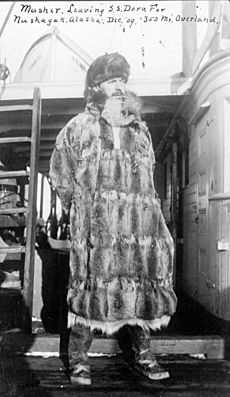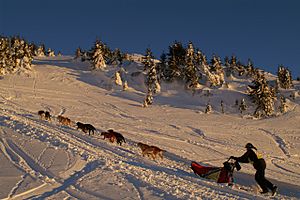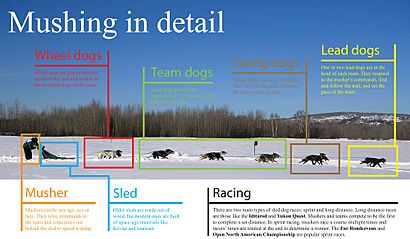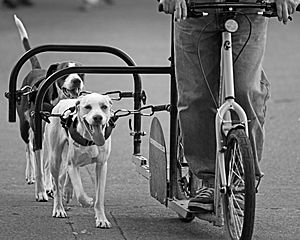Mushing facts for kids

Mushing is a cool sport and a way to travel using dogs. It involves different activities where dogs pull things. These include carting (pulling carts), pulka (pulling small sleds), dog scootering, sled dog racing, skijoring (dogs pulling a skier), and weight pulling. More simply, mushing means using one or more dogs to pull a sled on snow or a special vehicle called a rig on dry ground.
Contents
History of Mushing

People have used dogs to pull sleds for a very long time. This practice started at least 4,000 years ago! It began in places like Siberia or North America. Many Native American groups used dogs to carry heavy loads.
In 1534, a French explorer named Jacques Cartier arrived in North America. He claimed the land for France. For many years, the Iroquois people and the French had conflicts. To help, Samuel de Champlain sent young French men to live with the natives. These men, called coureurs des bois (which means "runners of the woods"), learned the native languages and customs. They were the first European mushers in North America. They helped France spread its influence. By 1609, France controlled a large area of Canada. In winter, sleds pulled by dogs became the main way to travel in this region.
In 1760, the British Army took control of Canada. Many coureurs des bois continued to use sled dogs. The French command word Marche! (meaning "walk" or "move") became "Mush!" in English.
During the Klondike Gold Rush, many people rushed to the Yukon to find gold. They brought sled dogs with them. This famous gold rush was even written about by American author Jack London in his book The Call of the Wild. Sled dogs became the most common way to travel in the Yukon and in the new US Territory of Alaska.
In 1911, a Norwegian explorer named Roald Amundsen used sled dogs to race to the South Pole. He was the first person to reach it! His competitor, Robert Falcon Scott, used Siberian ponies instead and sadly did not survive.
By the time of World War I, mushing was also popular in European countries like Norway. Dog sleds were used for nature tours, as ambulances in the mountains, and to bring supplies to soldiers.
A very famous event happened in 1925. Twenty mushers and about 150 sled dogs worked together. They carried diphtheria antitoxin (medicine) for about 674 miles (1,085 km) across Alaska. They did this in just five and a half days! This amazing effort saved the city of Nome and nearby towns from a serious illness.
What "Mush!" Means
France was the first European country to settle in the Canadian Shield. So, the early French explorers and traders, called coureurs des bois and voyageurs, used the French word marche!. This word means "walk" or "move." They used it to tell their dog teams to start pulling. Over time, for English Canadians, Marche! became "Mush!" Today, the word "Mush!" is not used very often.
How Mushing is Practiced
Mushing can be for work, for fun, or for competition. As a sport, mushing is popular worldwide. It's especially big in North America, northern Europe, and the Alps mountains. Groups like the International Federation of Sleddog Sports (IFSS) are working to make mushing an Olympic sport. Mushing is already the official state sport of Alaska!
Some of the most famous sled dog races in the world are:
- Finnmarksløpet in Norway
- Iditarod Trail Sled Dog Race in Alaska
- La Grande Odyssée in France and Switzerland
- Yukon Quest in Alaska and the Yukon
Even though dog sled racing gets a lot of attention, many families enjoy mushing just for fun. It's a great way to get outdoor exercise in the winter.
Mushing for work means using dogs to haul wood, deliver mail, or travel in rural areas. While snowmobiles have replaced dogs in many places, some trappers and people in isolated areas still use sled dogs. They find dogs safer and more reliable in very bad weather.
Dog Team Members
Each dog in a team has a special job based on its position. These jobs include leaders (or lead dogs), swing dogs, team dogs, and wheelers (or wheel dogs).
Lead dogs are at the front. They guide the team and set the speed. Sometimes there's one leader, but often there are two. Good lead dogs are smart, take initiative, and can find the trail even in tough conditions.
Swing dogs or point dogs are right behind the leaders. They help the rest of the team turn smoothly around curves on the trail.
Team dogs are in the middle of the team. They add power and strength. Smaller teams might not have dogs in this position.
Wheel dogs are the dogs closest to the sled and the musher. A good wheel dog needs to be calm so the moving sled doesn't scare them. They are strong and steady, helping to guide the sled around tight turns.
In the past, sled dogs might run in one or two straight lines. Now, most dogs run in two lines, even if there's only one person driving the sled.
Bikejoring
Bikejoring is a type of dog mushing. It's similar to skijoring (dogs pulling a skier) and canicross (dogs pulling a runner). In bikejoring, one or more dogs are connected to a bicycle with a special rope. Bikejoring and canicross likely grew out of skijoring and dog sled racing. It's also used to train racing sled dogs when there's no snow.
There are also special attachments that let a dog run beside a bicycle. These are often safer for city areas. These attachments usually have a spring to absorb shocks. Some can be put on either side of the bike, so you can exercise two dogs at once.
Dog Scootering
Dog scootering involves one or more dogs pulling a person riding an unmotorized kick scooter. It's like mushing, but it's done without snow and usually with fewer dogs. The dogs wear the same harnesses as sled dogs. They are connected to the scooter with a special line called a gangline. This line often has a bungee cord to make the ride smoother when the dogs speed up. People who do dog scootering often meet for fun runs. This is a growing activity, and some formal dog races now include scooter events.
Images for kids
See also
 In Spanish: Mushing para niños
In Spanish: Mushing para niños







